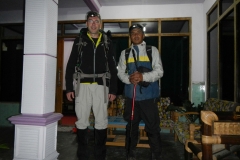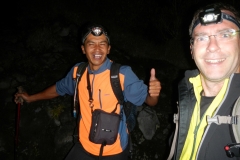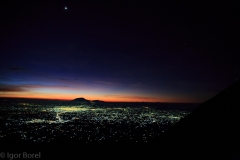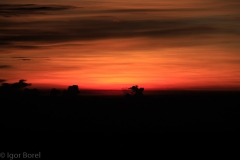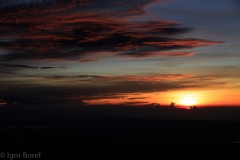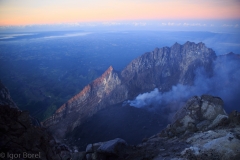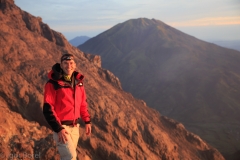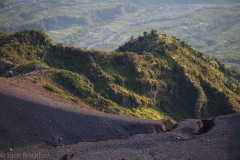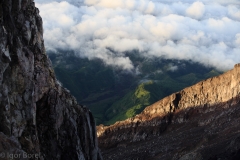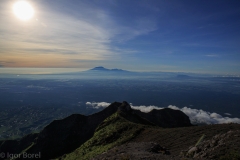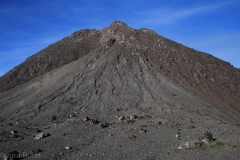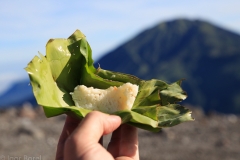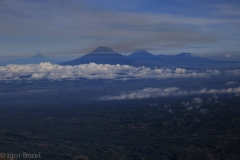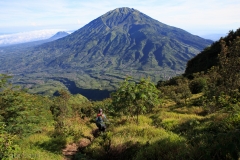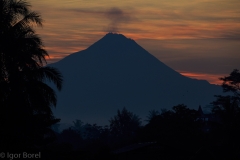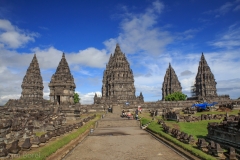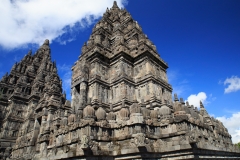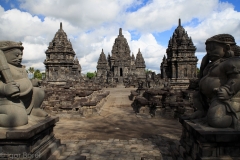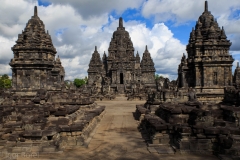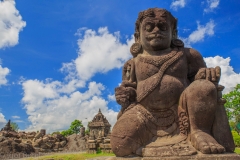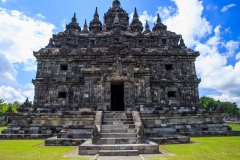Mt. Merapi
2.914m
29. Apr. 2014
Literally Merapi means “mountain of fire”. It is stated as the most active volcano in Indonesia, the last big eruption in 2010 killed 30 people and covered the surrounding area including the famous temple Borobodur with 10 cm ashes.
In the internet I found the contact data of the local guide located in Selo, at the foot of Mt. Merapi. Due to changing volcanic activity it is strongly recommended to hire a local guide. Besides for me as newcomer to Indonesia it was convenient way to access the mountain. Suroto Sheby, phone: +6285640657456 / +6287835090433, email: surotosheby@ymail.com.
He can arrange all kind of hiking packages, including pickup from Yogyakarta. It takes about two hours from Jogja (Yogyakarta).
The driver picked me up at 10:00 p.m. at my hotel in Jogja and we reached Selo about midnight. My plan was to watch the sunrise from the mountain top and we scheduled the hike accordingly. At 1:00 a.m. we left the base (house of Mr. Suroto) and walked though the quite village. After half an hour we reached the hiking entrance – from here a path leads up the mountain. The path was visible well, easy to find and to walk. The night was clear and we could see the dark shape of Mt. Merbabu. There are three rest areas on the way up, then we reached the plateau at about 2.700m. It is a good place to wait until the time for the final hike has come. On the plateau a volcanic observation station is located and while waiting, my guide checked the seismic activity. The mountain was calm that night and so we started at 4:30 a.m. The next 150 meters we climbed in small pellets and gravel – the ground was unstable and it became absolutely tiring for us. After the gravel field the last 50 meters consist of rocks. Another group of four hikers plus guide had the same plan and followed us to the top. When we reached the top about 5:20 the sky was already colored in bright orange. After the last eruption the center of the volcano collapsed and formed a crater which is opened on the east side. The last lava flow cut an aisle through the brim. Therefore, at the moment the mountain-top is just a thin ridge, only about 1.5 meters wide. On the one side you look down about 150 meters into the crater. On the other side it goes down about 300 meters to the plateau. A spectacular point to watch the sunrise which was at 5:38 am that day.
And somehow my guide managed to make a hot coffee for us. Absolutely delicious!
Watching east I forgot the time and was caught by the sunrise and my thoughts.
At 6:10 we left the top and went back down, climbed a small side-volcano and took the breakfast break on the plateau.
A specialty he brought for us was fermented rice in banana-leaves. Looks like a rice ball and tastes like sweet sake. Please be careful when you eat this in the mountain!
It was a sunny day and we had a nice view on Mt. Merbabu. During the hike we did not see any bigger animals except one eagle. The locals told me, that after the last eruption one month ago, all monkeys left Mt. Merapi and settled over to Mt. Merabu. I wondered if I would be able to see them there.
The road to Selo is a small, winding mountain road and leads to the starting points for climbing Mt. Merapi and Mt. Meboro. Selo is a small village located about 1550 meters high on the saddle between those tho mountains. Around the houses many small fields cover the mountain slops. The farmers grow all kind of vegetables, for me, it was interesting to see, that several different vegetables are planted mixed on the same field, mostly 3-4 different types containing carrot, cabbage, salad, porridge, broccoli. And those vegetables tasted so good!
Hiking key data:
Village Guide house: 1.665m 1:15 am
Merapi Plateau: 2.685m 3:50 am
Merapi Top: 2.914m 5:15 am
Merapi Plateau: 2.685m 7:05 am
Village Guide house: 1.665m 9:35 am
If you have a chance to come to this area, don’t miss to visit the famous temples at Yogjakarta.

